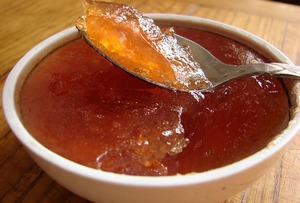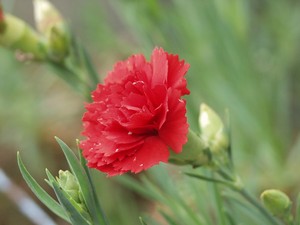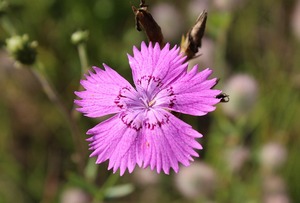In The Pinks
March 9, 2022
The Carnation has been used medicinally for approximately 2000 years, at least in China. This site gives a good account of its use there.
Gerard tells us of the carnation:
“The conserve made of the floures of the Clove Gillofloure and sugar, is exceeding cordiall,and wonderfully above measure doth comfort the heart, being eaten now and then.”
and
“It prevaileth against hot pestilentiall fevers, expelleth the poison and furie of the disease , and greatly comforteth the sicke.”

He differentiates between the carnation and the pink.
“The Pinke is called of Pliny and Turner, Cantabrica and Statice:of Fuchsius and dodonans,
Vetonica altera, and Vetonica altilis of Lobelius and Fucbsius,Superba: in French, Gyrofflees, Oeilletz and violcttcs herbues ; in Italian, Garofoli and Garoni in Spanish, Clauis ; in English, Pinkes and small Honesties.”


Of its use he says:
“These are not used in Physicke,but esteemed for their use in Garlands and Nosegaies. They are good to be put into Vinegre,to give it a pleasant taste and gallant coIour,as Ruellius writeth. Fuchsius saith, that the roots are commended against the infection of the plague ; and that the juyce thereof is profitable to waste away the stone, and to drive it forth : and likewise to cure them that have the falling sickenesse.”
![Ford Madox Brown [Public domain], via Wikimedia Commons Ford Madox Brown [Public domain], via Wikimedia Commons](https://echoesofthegarden.net/wp-content/uploads/2017/03/The_Nosegay-web-e1556478579413.jpg)
Culpepper says of the carnation:
Government and virtues. This plant belongs to Venus in Aries. The beauties of this plant in its wild state were too conspicuous to escape the notice of the florists, who, by their unwearied attention to its culture, have raised from it all that vast and beautiful variety of carnations which they justly esteemed the pride of their gardens. The flowers are the part to be made use of in physic. A strong decoction of them is an excellent medicine in malignant fevers; it powerfully promotes perspiration and the urinary discharge, without the least irritation, and at the same time raises the spirits, and quenches thirst.
They are cordial, and of considerable efficacy in dejection of spirits, faintings, head-aches, and other nervous complaints. There is a syrup of them kept in the shops, but it is too much loaded with sugar to be of any great use. Perhaps the best preparation of them is a strong tincture in brandy.
In case you'd like to try Culpepper's suggestion, you can read here for directions on how to make a brandy tincture or you can check out this video.
Dioscorides called it “Bettonike” and recommended it as an astringent against gangrenous ulcers on the mouth and tonsils and to aid against night walking, harmful places, and difficult sleep.
This is an in-depth ethnobotanical report on the uses of many, if not all, members of this family.
Here is an article on how your pet might benefit from the use of it.
I have found a few sites that mention ancient Aztec use of carnations in their medicine. I am at somewhat of a loss to explain this, since the Aztec Empire fell in 1521 with the coming of the Spaniards and the first mention of carnations in the Americas is in 1676 by Thomas Glover in his Account of Virginia. I have been unable to find any mention of when carnations were brought to South America. If you are interested in this particular topic, I recommend diligent research before trying any recipes ascribed to this place and time. If you have any information that might clear my confusion, please let me know in the comments below. Thanks.
Thanks for stopping by!
